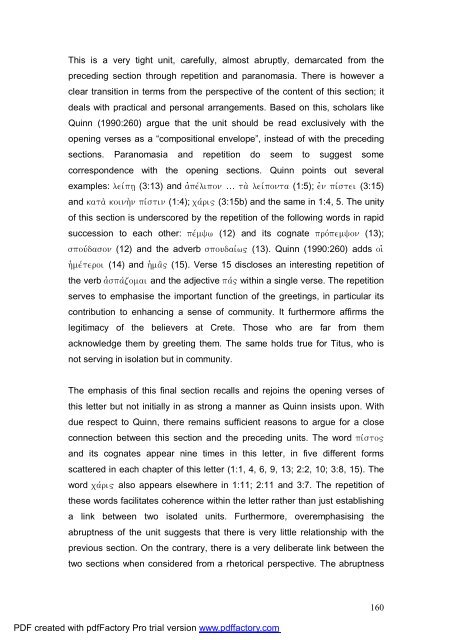A Text centred rhetorical analysis of Paul's Letter to Titus
A Text centred rhetorical analysis of Paul's Letter to Titus
A Text centred rhetorical analysis of Paul's Letter to Titus
You also want an ePaper? Increase the reach of your titles
YUMPU automatically turns print PDFs into web optimized ePapers that Google loves.
This is a very tight unit, carefully, almost abruptly, demarcated from the<br />
preceding section through repetition and paranomasia. There is however a<br />
clear transition in terms from the perspective <strong>of</strong> the content <strong>of</strong> this section; it<br />
deals with practical and personal arrangements. Based on this, scholars like<br />
Quinn (1990:260) argue that the unit should be read exclusively with the<br />
opening verses as a “compositional envelope”, instead <strong>of</strong> with the preceding<br />
sections. Paranomasia and repetition do seem <strong>to</strong> suggest some<br />
correspondence with the opening sections. Quinn points out several<br />
examples: leivph/ (3:13) and ajpevlipon … ta; leivponta (1:5); ejn pivstei (3:15)<br />
and kata; koinh;n pivstin (1:4); cavri" (3:15b) and the same in 1:4, 5. The unity<br />
<strong>of</strong> this section is underscored by the repetition <strong>of</strong> the following words in rapid<br />
succession <strong>to</strong> each other: pevmyw (12) and its cognate provpemyon (13);<br />
spouvdason (12) and the adverb spoudaivw" (13). Quinn (1990:260) adds oiJ<br />
hJmevteroi (14) and hJma`" (15). Verse 15 discloses an interesting repetition <strong>of</strong><br />
the verb ajspavzomai and the adjective pav~ within a single verse. The repetition<br />
serves <strong>to</strong> emphasise the important function <strong>of</strong> the greetings, in particular its<br />
contribution <strong>to</strong> enhancing a sense <strong>of</strong> community. It furthermore affirms the<br />
legitimacy <strong>of</strong> the believers at Crete. Those who are far from them<br />
acknowledge them by greeting them. The same holds true for <strong>Titus</strong>, who is<br />
not serving in isolation but in community.<br />
The emphasis <strong>of</strong> this final section recalls and rejoins the opening verses <strong>of</strong><br />
this letter but not initially in as strong a manner as Quinn insists upon. With<br />
due respect <strong>to</strong> Quinn, there remains sufficient reasons <strong>to</strong> argue for a close<br />
connection between this section and the preceding units. The word pivs<strong>to</strong>~<br />
and its cognates appear nine times in this letter, in five different forms<br />
scattered in each chapter <strong>of</strong> this letter (1:1, 4, 6, 9, 13; 2:2, 10; 3:8, 15). The<br />
word cavri" also appears elsewhere in 1:11; 2:11 and 3:7. The repetition <strong>of</strong><br />
these words facilitates coherence within the letter rather than just establishing<br />
a link between two isolated units. Furthermore, overemphasising the<br />
abruptness <strong>of</strong> the unit suggests that there is very little relationship with the<br />
previous section. On the contrary, there is a very deliberate link between the<br />
two sections when considered from a <strong>rhe<strong>to</strong>rical</strong> perspective. The abruptness<br />
PDF created with pdfFac<strong>to</strong>ry Pro trial version www.pdffac<strong>to</strong>ry.com<br />
160

















